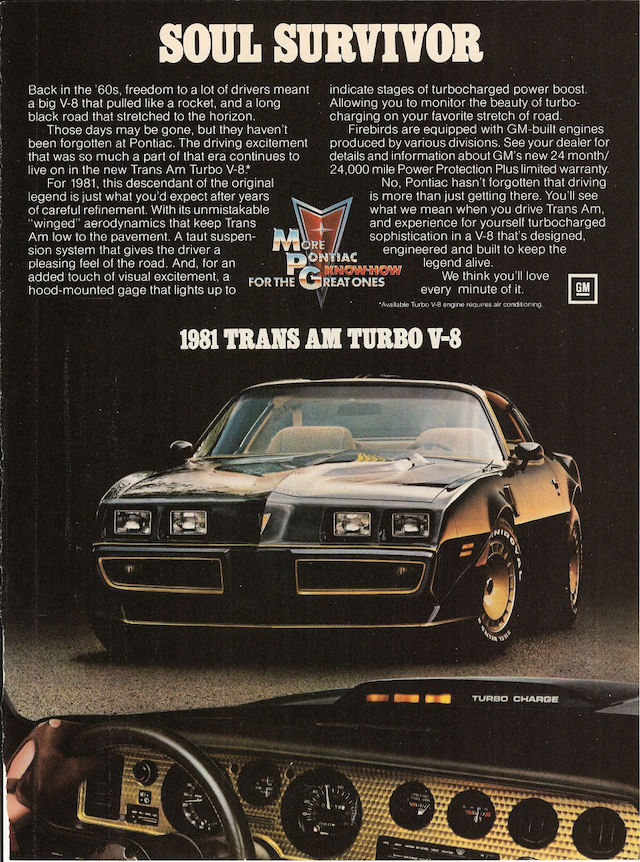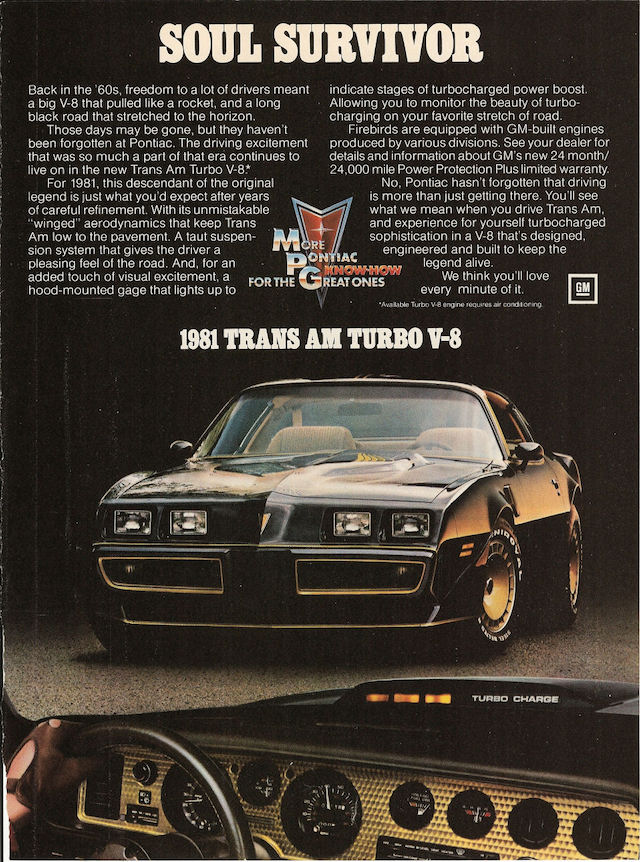SOUL SURVIVOR. – Rants – Autoextremist.com ~ the bare-knuckled, unvarnished, high-electron truth…

By Peter M. DeLorenzo
Detroit. That I have a deep like of every little thing Pontiac is properly regarded. I grew up immersed in this business enterprise – suitable in the thick of GM’s heyday – and Pontiac performed a crucial position in both my formative years and my early marketing career. Which is why when GM took the bankruptcy capsule in 2008, I was crushingly unhappy to learn that the Pontiac Division was a person of the belongings to be jettisoned. (And Hummer, way too, but the good news is that nameplate has now returned.)
It is tough to believe now, but Pontiac was just yet another GM division back again in the mid-50s. It experienced a lineup of stodgy cars and trucks, and there was very little to create property about. The division existed below the GM company umbrella, but it was decidedly missing in just about anything when when compared to GM’s other divisions: Buick, Cadillac, Chevrolet and Oldsmobile. But that would all improve when Bunkie Knudsen was appointed a GM vice president and the division’s standard supervisor in July of 1958. Knudsen was presented the assignment to inject some life into the division and maximize gross sales, and he was provided carte blanche to do it.
As a reminder, if you ended up a GM vice president and divisional normal manager back again in the working day you ended up akin to a potentate managing a small place. GM’s divisional common professionals had enormous electrical power with responsibility for engineering, manufacturing, sales and marketing. Considering about that in comparison with how matters work today, it doesn’t seem actual, because it was so drastically various from present day auto company it is like looking through from a fairytale guide. But make no error, it was really real, and GM’s divisional typical managers ended up like giants roaming the earth, swashbuckling their way by way of the working day-to-working day of the business even though generating crucial, pivotal decisions on the fly. Bear in mind, this was a enterprise that debuted new cars every single slide with new sheet steel and new attributes to go with them. Once more, in comparison with how items are carried out right now, it’s just jaw-dropping to ponder how the small business churned back again then. Of course, as I’ve reported quite a few, several moments in advance of, it was a distinct time and a unique period, but GM’s heyday was truly remarkable in that the corporation soared mainly because of it, even with the bean counters trying to rein things in every single step of the way.
The only arena where GM’s divisional standard supervisors experienced to consider a action again was when working with GM Styling, which was run with an iron fist by design and style legend Monthly bill Mitchell, who inherited the mantle from Harley Earl. The clashes among Mitchell and GM’s divisional typical managers had been legendary, and I will help save those people tales for another column. But suffice to say, Mitchell bought what he preferred for the most element, even if he experienced to perform the divisional standard administrators off towards each individual other to do so.
But back to Bunkie and Pontiac. His very first hires had been two younger and gifted engineers – Pete Estes from Oldsmobile and John Z. DeLorean from Packard. The cost to DeLorean was incredibly precise: get Pontiac into the general performance business proper now. And considering that Bunkie was a huge racing fanatic, everything was on the desk, from NASCAR to drag racing.
And all of a unexpected, incredibly hot Pontiacs stuffed with huge V8s started off to demonstrate up just about everywhere, from Daytona to Pomona. And even in our driveway. Given that Bunkie and his wife were being social pals with my mom and dad, Bunkie begun sending the best Pontiacs to our household precisely for my mom to travel. Beginning in the summer months of 1959, we had a series of Bonneville and Catalina convertibles that ended up usually bright red with a white top and a brilliant crimson interior. And they were usually equipped with the hottest Pontiac engine at the time, which at very first were being 389 cu. in. V8s with 3×2-barrell carbs, and at some point 421 cu.in. V8s. Useless to say, my mom loved her hot Pontiacs. (And my brother and I did, much too, specially because he had just gotten his license and we would “exercise” mom’s cars and trucks at every chance.)
The transformation of the Pontiac Division is a wonderful aspect of GM lore. Pontiacs went from staying sensible transportation devices to some of the hottest autos in the field. Giving overall performance engineering and styling that just weren’t available anywhere else, Pontiac rode a wave of popularity that took the company – and GM – by storm.
I say GM due to the fact, bear in mind that component about GM’s divisional vice presidents being akin to potentates of their very own nations? Very well, that was genuine, till Pontiac – below Bunkie Knudsen’s tutelage – started to upset the pecking order in just the organization. Prior to Pontiac became a “problem” for the other basic managers, the GM divisional hierarchy was obvious: Cadillac was up and off to the side luxuriating in its have rarified world. Buick was future in phrases of prestige, with the tremendous-well-liked Chevrolet sucking up all of the air in the room mainly because of its outstanding revenue quantities, followed by Oldsmobile, which just chugged alongside, and then the moribund Pontiac.
At least that’s the way it employed to be ahead of Bunkie and his “pirates” acquired rolling. All of a sudden, matters experienced adjusted. Chevrolet, which rather a great deal had large-general performance marketing possibilities cornered within just GM, was staying critically pushed by Pontiac on all fronts. Chevrolet operatives turned more incensed with each Pontiac foray into their territory, and the intramural battles involving the two divisions spilled over all the way to GM’s vaunted 14th floor, with whining Chevrolet executives complaining to top rated GM execs that Pontiac was deliberately encroaching on Chevy’s territory. As you can visualize, this did not sit well with Knudsen and DeLorean & Co. The growing product sales numbers, on the other hand, were being in Pontiac’s favor so GM’s top execs pretty a great deal allow Pontiac go, which additional even much more fuel to Chevy’s fireplace.
Then, in 1963, when GM issued its official ban in opposition to the participation in racing as company coverage (a monumentally chicken-shit final decision, by the way), the divisional typical managers experienced to comply. (This is when Zora Arkus-Duntov, somewhat than destroying the Corvette Grand Sports activities, sent them to trustworthy racer good friends of the firm, for fundamentally no cost. And the company’s deeply embedded marriage with Jim Hall’s Chaparral cars went absolutely underground.)
The very little-recognized collateral injury from that anti-racing ban was a GM internal edict that prohibited sure sized V8 from remaining set in “smaller” autos, which is a joke considering those people smaller cars ended up large by today’s criteria. The Chevrolet operatives dutifully complied with the edict, though Pontiac operatives, led by DeLorean and Invoice Collins – the gifted engineer who warrants most of the credit for this subsequent piece of automotive history – resolved to go in one more course. Right before the racing ban, Collins experienced been occupied stuffing Pontiac’s 389-cu.in. V8s into “intermediate” Le Mans bodies, and the result was, pointless to say, magical. But when the edict took outcome, Pontiac was exclusively ordered not to things a V8 into a Le Mans to make it into a new Pontiac model.
Then, a bit of genius. Pontiac operatives made the decision to get all over the ban by producing the “GTO” a new selection package on the 1964 Pontiac Le Mans. And the rest, as they say, is automotive historical past, as the initial “muscle” car was born. Chevrolet operatives had been apoplectic, but by the time GM corporate got wind of what was going on, the GTO choice experienced develop into 1 of the most sought-immediately after superior-efficiency alternative deals in the market. And by 1966 it grew to become its very own separate model.
Pontiac was crimson-incredibly hot, with its distinctive manufacturer of higher-effectiveness engineering and some of GM Styling’s greatest models coming in wave right after wave. From there, Pontiac would pile accomplishment upon success, achieving, at one particular point, a few million in yearly gross sales. The rebels out in Pontiac, Michigan, experienced gained.
And practically the greatest component? Pontiac was supported by sensational marketing, evidently some of the very best and most memorable promotion in the vehicle enterprise at the time. That pissed off Chevrolet’s advert agency – Campbell-Ewald – on a common foundation, which manufactured it even superior.
As for the intramural battle concerning Chevrolet and Pontiac, it continued. Pontiac came out with the Grand Prix in 1962, and the extended-nosed ’69 variation pushed by DeLorean was a further big strike. Chevrolet came out with the Camaro in 1967, but the Pontiac Firebird to some, was improved hunting. The ’70 Camaro, which was extraordinary in its very own right, was undercut by the fabulous ‘70 Pontiac Firebird Trans-Am and Firebird Method. As late as 1984, when Pontiac arrived out with the mid-engine Fiero, the fight ongoing. Chevrolet insisted that it could not encroach on Corvette territory, so the Fiero was restricted to a 4-cylinder at intro and received a V6 right in advance of it was dropped. The 2nd-era Fiero, which I experienced the enjoyment of viewing, had “Corvette-killer” written all in excess of it, but there was merely no way Chevrolet operatives were being going to allow it to see the mild of day, so they lobbied from it seriously, and it by no means did.
The Pontiac tale is worthy of telling. And it’s not just simply because of the wonderful vehicles and nameplates like Bonneville, Catalina, Fiero, Firebird, Grand Prix, GTO and Le Mans. It is simply because a bunch of maverick Accurate Believers thumbed their noses at the company inertia that threatened to overrun GM at the time and dared to go up versus an intramural corporate rival to provide some of the very best and most unforgettable equipment to come out of Detroit.
I experienced the enjoyment of performing on Pontiac advertising and marketing at D’Arcy MacManus & Masius from 1980-1985, and I will hardly ever forget it. Even nevertheless the small business was fast switching and Pontiac was starting to get rid of its id inside of the GM corporate monolith, the spirit of the former ad greats that came ahead of me and my advert colleagues was as extreme, vibrant and visceral as it could be. And we worked to make them very pleased each damn day.
Is this a plea for GM to resurrect Pontiac? That is a tough “no.” Pontiac existed in a fleeting second in time and remaining its indelible mark on automotive background – never to be repeated, but by no means to be overlooked.
And that’s the Substantial-Octane Fact for this 7 days.
 (Pontiac)
(Pontiac)
Editor’s Notice: This is Peter’s famous advert for the 1981 Pontiac Trans Am Turbo V-8. As Peter claims, “It was a distinctive time and a various period.” More true phrases ended up hardly ever spoken. -WG








